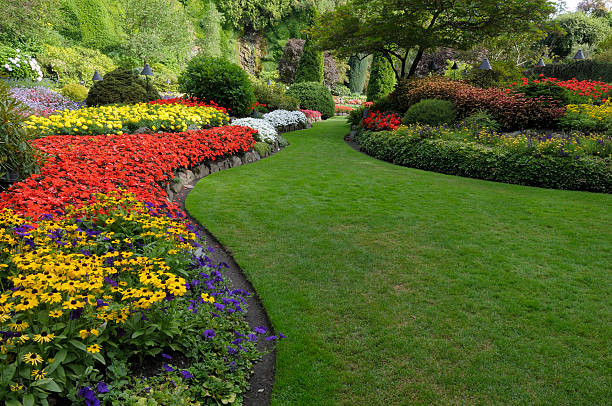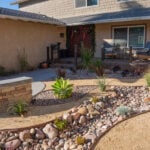Landscape Design: An Art of Breathtaking Symphonies of Nature and Human Creativity
Landscape design is the art of shaping outdoor spaces into breathtaking symphonies of nature and human creativity. it is an age-old practice that transcends mere aesthetics. These masterpieces not only enchant the eye but also harmonize with the environment, creating spaces that inspire and rejuvenate. Whether it’s a cozy backyard or a grand public park, landscape design is a testament to the coexistence of mankind and nature. Furthermore, that is while crafting functional, awe-inspiring landscapes and sustainable landscape designs. Unveiling the secrets behind this remarkable work of art known as landscape designs, we will delve into the elements, principles, historical evolution, and sustainable aspects of landscape design.
Forging a Profound Connection:
Landscape designs forge a profound connection between people and their surroundings. Landscape design forges a profound connection between people and their surroundings. Designers breathe life into landscapes that celebrate the diversity and beauty of the natural world. By incorporating nature elements of land with human interventions designers create a beautiful landscape. Landscape design is a blend of several disciplines, including architecture, horticulture, environmental science, and artistry, each contributing to the creation of a harmonious space.
Ancient Landscapes to Modern Innovations:
- Ancient Landscapes: you can trace back landscape design to the roots of old civilizations like Persians, Egyptians, and Chinese cultures. In the old times landscape designs and gardens used to reflect cultural beliefs, offering spiritual and aesthetic solace.
- Renaissance Gardens: the Europeans are known for their exquisite architecture and landscapes. The Renaissance period in Europe saw a revival of classical ideals. During this era gardens during this era embraced symmetry, geometric patterns, and the use of water features for focal points.
- English Landscape Gardens: In the 18th century, the English landscape garden movement emerged as a reaction against formal, structured gardens. It emphasized a more naturalistic approach, incorporating rolling lawns, meandering paths, and picturesque vistas.
- 19th Century and Beyond: urbanization came with Industrial Revolution. Furthermore, public parks became essential for city dwellers. Notable landscape architects like Frederick Law Olmsted pioneered landscape design for parks such as New York’s Central Park.
- Modern and Contemporary Landscape Design: Moreover, in the 20th and 21st centuries, there was a shift towards innovative and sustainable designs. They were focusing on ecological harmony, efficient space utilization, and bold architectural forms.
Principles of Landscape Design Unveiled
- Unity: the coexistence of various elements in a landscape is known as unity. The selection of a consistent colour, a dominant theme and a cohesive design language designers create a sense of unity within the place.
- Balance: Balance is the distribution of visual weight in a landscape. Symmetrical, asymmetrical, and radial balance are commonly used to evoke feelings of stability, harmony, or dynamism.
- Proportion and Scale: within the landscape, the relationship between different elements is referred to as Proportion and scale. Correctly gauging these relationships ensures that the design is neither overwhelming nor underwhelming.
- Rhythm: to introduce a sense of movement and to guide the eye through the landscape you apply rhythm. To create a harmonious experience, patterns colors and repetition of forms help create a rhythm in your landscapes.
- Focal Points: strategically placed elements that attract the viewer’s attention, adding spice and drama, and interest to the landscape are known as the focal points.
Breathing Life into Outdoor Spaces
- Plants and Vegetation: plants and vegetation are The heart and soul of any landscape plants and vegetation provide a myriad of colors, textures, and scents. These living elements breathe life into the design, from majestic trees to delicate flowers
- Hardscaping: to escape the living elements you implement hardscaping. Hardscaping encompasses non-living elements such as pathways, patios, decks, walls, and sculptures. It provides structure and functionality to the landscape.
- Water Features: the addition of Ponds, waterfalls, fountains, and even small streams. Furthermore, introduce a soothing and captivating element, reflecting light and sound while inviting tranquility.
- Lighting: Thoughtful use of lighting enhances the landscape’s beauty during the night, adding a touch of enchantment and safety. It helps brighten up your landscape and brings a sense of togetherness to the landscape.
- Furniture and Accessories: Outdoor furniture, decorative elements, and art pieces personalize the landscape, making it inviting and comfortable for users. It furthermore brings structure and dimension to your landscape.
Nurturing Nature for a Greener Future
In a period of environmental knowledge, sustainable landscape design has become an important aspect of responsible landscaping. These practices reduce ecological footprints while nurturing the local ecosystem:
- Native Plants: Opting for native plants will be the best decision for you. This will also require less maintenance since being well-adapted to the climate. The need for water will also be less.
- Water Conservation: installation of smart irrigation systems, rain harvesting, and use of drought-tolerant plants will lead to a lot of ease for you. They help reduce water consumption and minimize waste.
- Permeable Surfaces: the use of permeable materials for pathways and driveways allows rainwater to refill groundwater instead of causing runoff. Therefore, also increases the life of your landscape.
- Composting: to reduce the need for chemical fertilizer you should use composting practices. It also helps enrich your soil and help grow beautiful gardens!
- Green Roofing and Vertical Gardens: Incorporating green roofs and vertical gardens helps insulate buildings, reduces the urban heat island effect, and provides more green space. Therefore, the more the merrier.
A Journey Through Landscape Design
Landscape design is an ode to the natural world and a beautiful expression of human innovation. To create extraordinary works of art that transcend time, throughout history, landscape designers have taken up cultural, environmental, and artistic influences. By sticking to unity, balance, proportion, rhythm, and focal points while mixing natural and man-made elements. Furthermore, landscapes become dazzling sanctuaries that rejuvenate, inspire, and sustain. Sustainable landscape design further makes our commitment permanent to improving the environment, making sure that these living masterpieces continue to prosper for generations to come.







